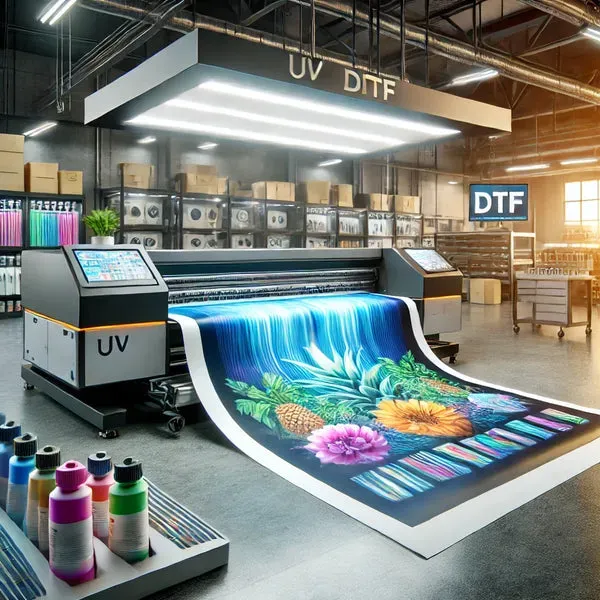UV DTF technology is revolutionizing the world of textile printing, combining the precision of digital printing technology with the versatility of direct-to-film methods. This innovative approach allows for the creation of stunning, high-resolution designs that can be easily transferred onto a variety of fabrics, making it a key player in modern textile printing innovations. As brands strive for sustainable textile printing solutions, UV DTF printing stands out for its eco-friendly inks and cost-efficient production processes. By minimizing waste and offering vibrant color options, this technology is perfect for custom fabric printing beyond traditional limitations. With UV DTF, the future of the textile industry is bright, sustainable, and endlessly creative.
UV Direct to Film (DTF) printing represents a cutting-edge stride within the realm of fabric decoration, seamlessly merging the latest digital printing techniques with direct film application. This method not only enhances the quality of printed designs but also broadens the scope of materials that can be utilized, catering to innovative demands in custom garment creation. As industries increasingly seek sustainable and efficient textile solutions, this advanced printing technology emerges as a pivotal option, promoting environmentally friendly practices along with advanced durability. The adoption of such textile printing innovations suggests a significant shift in how consumer products can be manufactured, prioritizing both quality and ecological responsibility. As these trends continue to evolve, UV DTF technology is likely to become synonymous with modern fabric printing excellence.
Exploring the Marvels of UV DTF Technology
UV DTF technology, or Direct to Film printing, is revolutionizing the textile printing landscape. By employing ultraviolet light to cure specialized inks on a film before transferring it to the fabric, this innovative approach offers unprecedented print quality. UV DTF printing is especially beneficial for intricate designs, capturing acute details and vibrant colors that traditional methods often struggle to achieve. This level of precision makes it possible for brands to push creative boundaries and craft products that truly stand out in the crowded marketplace.
Moreover, UV DTF technology is not limited to fabric printing; its versatility allows it to be used across various surfaces, from textiles to hard goods. This capability is a game changer for creative professionals and manufacturers alike, fostering a wealth of possibilities in custom fabric printing. Whether it’s sports jerseys or promotional items, UV DTF enables designers to cater to diverse consumer needs, ensuring they can deliver high-quality products that connect with their target audiences.
Sustainable Textile Printing Innovations
In recent years, sustainability has become a focal point in the textile printing industry, and UV DTF technology aligns perfectly with this trend. Many manufacturers are integrating eco-friendly inks into their UV DTF printing processes, which dramatically reduce harmful Volatile Organic Compounds (VOCs) compared to conventional methods. This commitment to sustainability not only aids in protecting the environment but also resonates with increasingly conscious consumers who prioritize eco-friendly products.
Additionally, the efficiency of UV DTF printing contributes to sustainability efforts by minimizing waste. The reduced material and labor costs associated with this technology come from its ability to print on demand, eliminating the need for large inventory stock. This adaptability makes UV DTF an ideal choice for sustainable textile printing, ensuring manufacturers can respond swiftly to market demands while maintaining an environmentally responsible approach.
Unmatched Quality in Print Production
One of the standout features of UV DTF printing is its superior print quality, largely attributed to the curing process that utilizes UV light. Unlike traditional direct-to-garment (DTG) or other textile printing methods, UV DTF creates prints that are not only vibrant but also exceptionally sharp and detailed. This is crucial for brands looking to create visually striking products that attract customers and build brand loyalty.
The technological advancements in UV DTF also enhance longevity. The durability of inks used in UV DTF printing means that prints resist fading and abrasion, maintaining their vibrant appearance through multiple washes and everyday wear. Such qualities are especially important for businesses in competitive markets like sportswear and fashion, where product quality can significantly influence consumer choice.
Cost-Efficient Solutions with UV DTF
In an era where operational efficiency is paramount, UV DTF technology emerges as a cost-effective solution for textile producers. By reducing setup times and eliminating the need for lengthy drying periods, businesses can streamline their production processes significantly. This efficiency is invaluable for companies operating under tight deadlines or those involved in custom fabric printing, enabling rapid turnaround times while ensuring high-quality output.
Furthermore, the lower material waste associated with UV DTF printing contributes to reduced overall costs. Businesses can print only what they need, responding dynamically to customer demands without overcommitting resources or inventory. This adaptability not only serves as a cost-saving strategy but also aligns with the industry’s growing commitment to sustainability.
The Growth of Adjustable textile printing Technology
As the textile printing landscape evolves, UV DTF technology is becoming increasingly popular among manufacturers seeking to enhance their production capabilities. The versatility of this technology allows for seamless printing on various substrates, making it an attractive option for apparel and home goods producers. This adaptability will likely result in a surge of demand as companies seek to diversify their product offerings.
Moreover, the growth trajectory of UV DTF is not just limited to larger manufacturers. Smaller printing operations are also finding innovative ways to incorporate this technology into their workflows. As software and equipment improve, accessibility increases, allowing businesses of all sizes to benefit from the efficiencies and high-quality outputs that UV DTF provides.
Real-World Applications and Case Studies
Many companies have already successfully integrated UV DTF technology into their operations, showcasing its versatility and effectiveness. Sportswear brands, for example, are increasingly utilizing UV DTF for producing vibrant, customized designs that resonate with younger consumers. The ability to create dynamic designs on-demand without sacrificing quality is a significant advantage in today’s fast-paced fashion landscape.
Similarly, custom apparel startups have embraced UV DTF for its on-demand manufacturing capabilities. This technology allows them to respond quickly to changing consumer preferences and deliver limited runs of bespoke designs. By minimizing the need for extensive inventory and waste, these startups can operate sustainably while satisfying niche market demands.
Frequently Asked Questions
What are the key benefits of UV DTF printing in textile printing innovations?
UV DTF printing offers numerous benefits in textile printing innovations, including superior print quality with vibrant colors and high-resolution images, versatility across various fabric types, enhanced durability against fading and scratches, environmentally friendly inks that reduce VOC emissions, and cost efficiency through minimized waste and reduced setup times.
How does UV DTF technology contribute to sustainable textile printing?
UV DTF technology contributes to sustainable textile printing by utilizing eco-friendly inks that lower voluntary organic compound (VOC) emissions compared to traditional methods. This technology also supports on-demand manufacturing, reducing material waste and enabling brands to practice more environmentally conscious production.
Can UV DTF printing be used on all types of fabrics?
Yes, UV DTF printing is highly versatile and can be used on a wide array of fabrics, including synthetic materials and hard surfaces. This adaptability makes UV DTF a popular choice for custom fabric printing across various industries, allowing designers to unleash their creativity.
What makes UV DTF printing superior to other digital printing technologies?
UV DTF printing is superior to other digital printing technologies due to its unique UV curing process, which ensures vibrant colors, sharp details, and improved durability. Compared to traditional DTF or inkjet printing, the UV DTF method offers higher quality outputs that remain vivid even after extensive washing.
How does UV DTF printing reduce production costs for manufacturers?
UV DTF printing reduces production costs through its efficient, quick setup and curing times, which minimize downtime. The technology’s ability to execute on-demand printing helps manufacturers save on materials and inventory costs, making it a cost-effective solution for producing custom textile products.
What real-world applications exist for UV DTF technology in the fashion industry?
Real-world applications of UV DTF technology in the fashion industry include sportswear brands creating intricate designs for trend-focused customers, custom apparel startups producing unique designs on demand, and sustainable fashion brands adopting UV DTF for environmentally friendly printing practices, showcasing its versatility and innovation.
| Key Aspect | Description |
|---|---|
| What is UV DTF Technology? | UV DTF printing utilizes ultraviolet light to cure inks on coated films, which are then transferred onto fabrics, enabling high-quality, intricate image production across various material types. |
| Advantages | 1. Superior Print Quality: Ensures vibrant colors and detailed images. 2. Versatility Across Fabrics: Suitable for various materials, including synthetics and hard surfaces. 3. Durability: Offers resistance to fading, scratches, and washing. 4. Environmentally Friendly: Many printers use eco-friendly inks, reducing VOC emissions. 5. Cost Efficiency: Reduces material and labor costs, ideal for on-demand manufacturing. |
| Industry Insights | The textile industry is adopting UV DTF technology to meet growth demands for high-quality, sustainable products, with continuous technological innovations promoting its accessibility and efficiency. |
| Real-World Applications | 1. Sportswear Brands: Creating dynamic designs for trend-focused customers. 2. Custom Apparel Startups: Quick production of bespoke designs. 3. Sustainable Fashion Brands: Minimizing waste while maximizing quality. |
| Future Outlook | UV DTF technology is positioned to redefine printing standards with advancements that increase speed and efficiency while expanding material compatibility, promoting innovation in quality and sustainability. |
Summary
UV DTF technology is revolutionizing the textile printing industry with its unmatched print quality and versatility. This advanced printing method not only supports a wide range of fabric types but also significantly enhances durability and environmental sustainability through the use of eco-friendly inks. As manufacturers increasingly recognize the benefits of adopting UV DTF, we can expect a transformative impact on product quality, cost efficiency, and creative possibilities in textile applications. Moving forward, UV DTF technology will undoubtedly shape the future of custom printing, providing innovative solutions that align with modern consumer demands for quality and sustainability.

